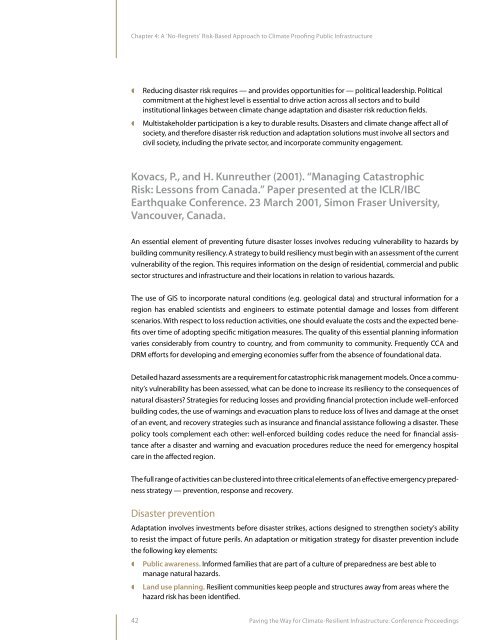Paving the Way for Climate-Resilient Infrastructure - UN CC:Learn
Paving the Way for Climate-Resilient Infrastructure - UN CC:Learn
Paving the Way for Climate-Resilient Infrastructure - UN CC:Learn
Create successful ePaper yourself
Turn your PDF publications into a flip-book with our unique Google optimized e-Paper software.
Chapter 4: A ‘No-Regrets’ Risk-Based Approach to <strong>Climate</strong> Proofing Public <strong>Infrastructure</strong>Reducing disaster risk requires — and provides opportunities <strong>for</strong> — political leadership. Politicalcommitment at <strong>the</strong> highest level is essential to drive action across all sectors and to buildinstitutional linkages between climate change adaptation and disaster risk reduction fields.Multistakeholder participation is a key to durable results. Disasters and climate change affect all ofsociety, and <strong>the</strong>re<strong>for</strong>e disaster risk reduction and adaptation solutions must involve all sectors andcivil society, including <strong>the</strong> private sector, and incorporate community engagement.Kovacs, P., and H. Kunreu<strong>the</strong>r (2001). “Managing CatastrophicRisk: Lessons from Canada.” Paper presented at <strong>the</strong> ICLR/IBCEarthquake Conference. 23 March 2001, Simon Fraser University,Vancouver, Canada.An essential element of preventing future disaster losses involves reducing vulnerability to hazards bybuilding community resiliency. A strategy to build resiliency must begin with an assessment of <strong>the</strong> currentvulnerability of <strong>the</strong> region. This requires in<strong>for</strong>mation on <strong>the</strong> design of residential, commercial and publicsector structures and infrastructure and <strong>the</strong>ir locations in relation to various hazards.The use of GIS to incorporate natural conditions (e.g. geological data) and structural in<strong>for</strong>mation <strong>for</strong> aregion has enabled scientists and engineers to estimate potential damage and losses from differentscenarios. With respect to loss reduction activities, one should evaluate <strong>the</strong> costs and <strong>the</strong> expected benefitsover time of adopting specific mitigation measures. The quality of this essential planning in<strong>for</strong>mationvaries considerably from country to country, and from community to community. Frequently <strong>CC</strong>A andDRM ef<strong>for</strong>ts <strong>for</strong> developing and emerging economies suffer from <strong>the</strong> absence of foundational data.Detailed hazard assessments are a requirement <strong>for</strong> catastrophic risk management models. Once a community’svulnerability has been assessed, what can be done to increase its resiliency to <strong>the</strong> consequences ofnatural disasters? Strategies <strong>for</strong> reducing losses and providing financial protection include well-en<strong>for</strong>cedbuilding codes, <strong>the</strong> use of warnings and evacuation plans to reduce loss of lives and damage at <strong>the</strong> onsetof an event, and recovery strategies such as insurance and financial assistance following a disaster. Thesepolicy tools complement each o<strong>the</strong>r: well-en<strong>for</strong>ced building codes reduce <strong>the</strong> need <strong>for</strong> financial assistanceafter a disaster and warning and evacuation procedures reduce <strong>the</strong> need <strong>for</strong> emergency hospitalcare in <strong>the</strong> affected region.The full range of activities can be clustered into three critical elements of an effective emergency preparednessstrategy — prevention, response and recovery.Disaster preventionAdaptation involves investments be<strong>for</strong>e disaster strikes, actions designed to streng<strong>the</strong>n society’s abilityto resist <strong>the</strong> impact of future perils. An adaptation or mitigation strategy <strong>for</strong> disaster prevention include<strong>the</strong> following key elements:Public awareness. In<strong>for</strong>med families that are part of a culture of preparedness are best able tomanage natural hazards.Land use planning. <strong>Resilient</strong> communities keep people and structures away from areas where <strong>the</strong>hazard risk has been identified.42<strong>Paving</strong> <strong>the</strong> <strong>Way</strong> <strong>for</strong> <strong>Climate</strong>-<strong>Resilient</strong> <strong>Infrastructure</strong>: Conference Proceedings
















